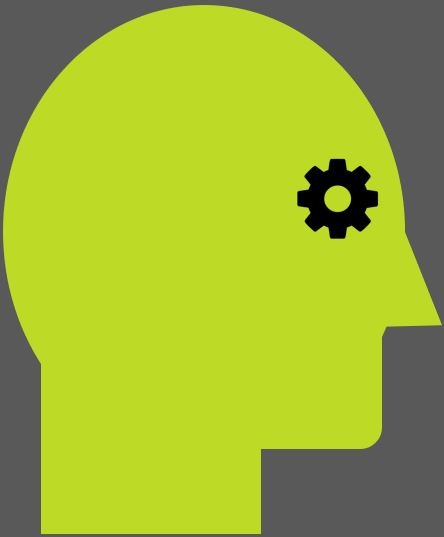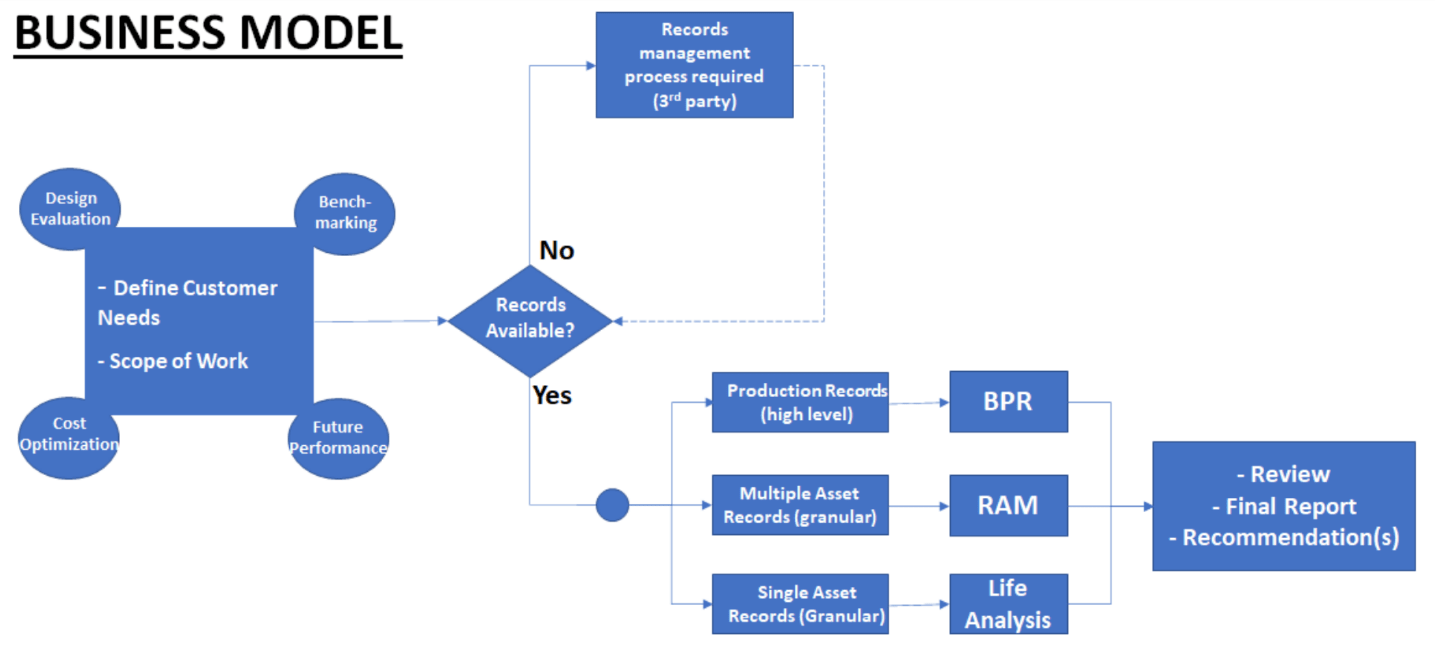
Core Speciality: Reliability Analysis and Block Diagram Modelling
Target customers: Industrial operations seeking to quantify the future performance of their assets in order to optimize financial budgets, production output and resource allocations (capital, work force, spare parts, etc.).
Definition of Reliability Modelling
Also known as Reliability, Availability and Maintainability (RAM) Modelling, this concept breaks down an operation or system into significant blocks and quantifies the interactions and ultimate contribution of each block to the total output of the operation (e.g. m3 of finished product, manufactured goods, mining ore, etc).
Once established, the model can inform the operator on various improvement opportunities related to each block including availability bottlenecks, maintenance optimization, spares parts management or maintenance resource allocation. The RAM model is also a tool of choice to estimate the benefits of changes to an operation
(e.g. adding redundancy) as it is cheaper to review the change on paper rather than in real life.
Definition Reliability Analysis
Two types of Reliability analysis are offered as follows
1) Life analysis often known as “Weibull analysis”: The concept uses statistical tools to define life characteristics of assets or components. Using historical variables such as operating time, odometer km or on/off cycles, one can define characteristics of equipment informing an operator of the future number of failures, probabilities of failures or define the bathtub curve characteristics of an asset.
2) Barringer Process Reliability: this concept is defined as a 10,000 ft overview of an operation and uses only production output data such as barrels per day, widgets produced per day etc. It is essentially a
management tool and can help the operator establish the operating characteristics of the asset as well as the real losses experienced by the asset. It can also be used as a benchmarking tool if for example
an operator has multiple production sites or several identical processing units on one site.

The fine print: The statistical analysis is based on the information and records provided by the client. The analysis provides guidance to what the asset(s) studied is expected to perform in the future based on past performance but does not guarantee any outcomes. It is strongly recommended that the client review the report and recommendations with subject matter experts to make final decisions.
But what is Reliability Engineering?
Reliability Engineering is an established science with rigorous concepts involving mathematical and statistical methods, and those can often appear daunting for some maintenance or risk practitioners. The role of the reliability engineer is to master, explain, and apply those concepts as well as work with peers to make the correct decision(s) regarding the maintenance of operating assets or future design capabilities. Those decisions are crucial, especially when it comes to the safety of frontline workers, capital investments, or the preservation of the environment. To use my fellow Reliability Engineer, Fred Shenkelberg’s1 own terms, the Reliability Engineer asks two simple questions:
- What will make the equipment fail?
- When will the equipment fail?
I have outlined 9 themes below as well as what "data" or information is required from the customer to do this. The fine print: all those reliability calculations are based on historical complete (clean) records provided by a customer. Changes in performance based on unknown events can occur and modify future performance. The statistical analysis provided to the customer is intended to guide their decision based on the likely but NOT guaranteed turnout of events.
1) What is the expected number of failures in a defined future interval of time on a specific asset or set of assets generally of the same type (e.g. cooler pumps).
The customer wants to know how many events he will have to deal with in the coming months or years so he can organize his resources (spare parts, labour, $ budgets, etc).
This requires a reliability study to develop a life model for the typical asset. The inputs to the study are failure/repair records (typically dates) and equipment start date. See Maintrain 2020 paper (on my website) for more details on this. The more detailed the customer records the better - sparse and incomplete records are difficult to work with though not impossible; otherwise have to default to literature-based models IF available but this might lead to approximative results. This study also gives the customer an idea on how "fast" the asset is deteriorating.
2) What is the economical number of spare parts we should have in our spares/supply chain inventory?
Spares are expensive and to get them to sit unused in our stores is wasting $$$. On the other hand, if we don't have them when we need them it can cost us downtime hence revenue $$$.
In order to find the optimal/most economical number of spares to keep in stock we must do a study as in 1) above on the asset and the apply the cost optimization technique. The inputs to the study are failure/repair records (typically dates), equipment start/commissioning dates, cost of repairs/maintenance and finally cost of downtime (typically lost production revenue). We also need to know the logistics to get spares in stock. This is also the technique we use to get spares min/max levels. Once this model is built, we can work with vendors to see how we can improve logistics or costs - e.g. keep spares on vendor sites rather than customer's warehouse.
3) When is it most economical to replace this asset with a new one?
Assets age and cost us more money over time in terms of repairs or loss of efficiency. However, if replaced too early that can be expensive especially if the replacement costs are high. If done too late it can cost us $ in terms of lost production especially if it is a catastrophic failure. We have to calculate the optimal time when the risk and costs are minimized. The same technique is used as in 2) above (i.e. economical replacement time). Similarly, we can calculate overhaul timing with this technique - when is the best time to send equipment for overhaul.
4) What is the economical benefit (or lack of thereof) of adding redundant/standby/spare equipment in order to a process.
Equipment failures can bring significant impact to a process especially if this equipment is a single point vulnerability (i.e. if it fails the entire process comes down). Redundancy can be a solution to the problem but it has to be carefully assessed especially if we are dealing with expensive retrofits. Redundancy would mean adding an identical unit in the process whereby if one unit fails, the other identical unit immediately takes over minimizing downtime production impact - the failed item can be repaired and brought back to a functional / stand-by-state. The Reliability technique used here is specifically described in the 2022 Maintrain Paper. It would require the typical CMMS records from the customer as well as production downtime costs and more importantly an accurate and complete cost of adding the redundant unit. We end up with a RAM model. A risk analysis process is also recommended to ensure the new unit does not result in undesirable outcomes like controls, process or hydraulic issues typically not covered by a reliability study.
5) Based on the current performance, what is the expected production output of the production unit or entire plant in a future interval of time?
Operators build a production plant and expect to get full production at the same rates every single day of the year. This is not the case in reality. Equipment fails, incidents happen and we have process quality mishaps which end up causing lower production outputs. Building a RAM model of the production plant including all its "significant" process units and the simulated failures times and impacts can help visualize the operation of the plant in a more realistic view. The RAM model output therefore can provide the most realistic performance (bbls, widgets, tonnes or ore, etc) of the plant say in the next 5,10, 20 years, etc. This can also highlight known bottlenecks and quantify their overall impact including production, maintenance costs and downtime. The RAM model should also include information about the operating philosophy of the plant or production unit (how it is used, % time used, turn ups or turn down proportion etc). If the plant has been in production for a while and has detailed output records, the BPR technique defined in the 2022 Maintrain Paper can be used. However this does not provide as detailed information as the RAM model yet is way much easier to build compared to a RAM model.
6) If this asset has survived to date without any catastrophic failure, what is the probability that it will survive another two years as this is how long it will take for us to replace it as well as find the $ budget.
This is used for critical assets that if they fail, will cause significant impact on production. Additionally, those assets cost a significant amount of $ to replace and have a long lead time as they are custom built and not an off the shelf item. For example, this could be a power transformer on an oil pipeline which takes two years to replace at a cost 10+ million dollars. Finding the probability of failure in the next short time interval (e.g. 2 years away) is a way to gauge the risk* and hence how long we can wait before the asset is replaced (Risk* = probability x consequence) . This probability is derived from the same analysis performed in 1) above. On a side note, just to point out that a Reliability Life Analysis on an asset can provide multiple answers to a customer so it is a very valuable and versatile process.
7) What is the maintenance strategy for this set or population of assets?
Maintrain Paper 2021 (Page 8) on my website gives an idea on how to develop part of a maintenance strategy that will enhance the availability of an asset or population of assets. The reliability calculations are the basis of this strategy but the implementation feasibility of the strategy should always be vetted by the customer. Another tool that is used to define a maintenance strategy is FMEAs (Failure Modes and Effects Analysis - a team driven process a bit like HAZOPs or PHAs). The Reliability Engineer in collaboration with other specialties, helps define a maintenance strategy that is based on the asset's historical performance rather than from a vendor's manual. The maintenance strategy can involve inspections, advanced condition monitoring or preventive replacements of components. The fundamental inputs to an optimal maintenance strategy are good equipment records and detailed knowledge of the asset (how it works and how it fails).
8) Can we quantify the bottle neck impact in a process (i.e. how much is the equipment that is causing problems really costing us in terms of repairs or revenue loss)?
Operators often know what is causing them losses in their process but the challenge is to quantify this loss in production units, revenue $$$ or downtime. This question works in conjunction with question 5. We have built a RAM model for the process where the "culprit" is included. We have to run the model for a desired interval (e.g. 5 years) and drill down to the bottle neck's contribution to lost revenue, downtime etc.
9) Big Vice President in Big Office want to know how his operation is doing on “one sheet of paper” without going into details of what’s broken
Barringer Process Reliability (or BPR) is a great tool for this. It needs minimal inputs and uses to the Weibull statistical process to define simple KPIs that highlight the performance of a plant or operation. It can also be used as a benchmarking tool if for example an operator has multiple production sites or several identical processing units on one site.
